Expert-Led Picks for Professional Services, Agencies, and PMOs
There are plenty of resource management software tools out there that enable you to improve resource planning and forecasting, but some shine above the rest. After some extensive research and reviews, here are our choices for the best resource management software.
Most review lists throw every scheduling tool into the same basket. We’ve taken a sharper approach with a focus on tools built for professional-services work, where billable hours, certifications, and client trust all hinge on getting resourcing right.
What this guide covers
Below you’ll find our 11 top-rated platforms for 2026, each evaluated on:
- Visibility: real-time view of capacity and demand
- Skills insight: how well the tool understands what people can actually do
- Financial context: tracking utilisation, costs, and profitability
- Ease of use: setup speed, UI design, and learning curve
- Integrations: how cleanly it connects with HR, ERP, and CRM systems
- AI and automation: new features that forecast needs or suggest matches automatically
We combined our own research with verified customer reviews from G2, Capterra, and TrustRadius to give you balanced insights.
Key takeaways
- Retain ranks #1 for professional services due to its skills-first, AI-powered planning.
- We reviewed 11 leading tools and compared features and real user feedback.
- Best for PS firms that need skills visibility, compliance filters, and cross-department views.
- Includes independent reviews from G2 and Capterra.
- Updated for 2026.
Next step: Book a demo of Retain →
Why Retain leads the 2026 shortlist
Among every platform we tested, Retain stood out for one clear reason: it’s designed from the ground up for professional-services resourcing. With Skills+ taxonomy, AI-powered matching, and behavioural insights, it gives firms a unified view of people, skills, and performance across Audit, Tax, and Advisory teams .
You’ll still find familiar tools here, such as Float, Resource Guru, Productive, and Dayshape, but the goal of this guide is to help you understand which tool actually fits your workflow.
How to use this review
- Short on time? Start with the comparison table.
- Need detail? Each section includes a mini review, ratings, and user quotes.
- Choosing for a PS firm? Jump to Retain Cloud (#1).
- After something lightweight? Check Float or monday.com.
Quick comparison: Best resource management software for 2026
Here’s how the top 11 resource management platforms compare on pricing, skills intelligence, AI capabilities, and user satisfaction. Each tool below was tested for professional-services readiness, feature depth, and verified user sentiment.
Disclaimer: While we strive to provide an accurate and fair comparison based on publicly available information, there may be additional features or context not reflected here. This post should not be considered exhaustive or definitive.
↪ Retain targets professional services teams that need skills-based planning. It offers AI skills matching combined with behavioural insights, giving you real-time visibility into skills, capacity, and certification tracking. The platform integrates with SAP, Dynamics 365, Salesforce, Workday, and IRIS.
↪ Float works best for visual scheduling with financial visibility. You get forecasting and utilisation tracking alongside a real-time capacity overview. It connects with Google Calendar, Slack, Jira, and Asana.
↪ Resource Guru handles quick team scheduling and workload heatmaps. The platform provides capacity insights and availability and clash management. It integrates with Outlook, Google Calendar, and Teams.
↪ Dayshape serves enterprise-scale firms with predictive AI scheduling. The system includes utilisation forecasting and scenario planning capabilities. It works with Salesforce, Power BI, and Workday.
↪ Productive suits agencies needing capacity forecasting and profitability tracking. Workload automation sits at its core, supported by skills tags and utilisation dashboards. The platform connects to Slack, Xero, QuickBooks, and HubSpot.
↪ Scoro delivers end-to-end project and financial control for firms that need both. You'll find utilisation and billing analytics alongside shared calendars and time tracking. It integrates with Xero, QuickBooks, Sage, and Expensify.
↪ Kantata focuses on people-centric resourcing for agencies. Scenario planning drives the platform, with role-based visibility keeping everyone informed. It works with Salesforce, Xero, and BambooHR.
↪ Hub Planner supports large companies managing multiple teams through automated scheduling. Resource heatmaps show you where capacity sits across your organisation. The system connects with Jira, Slack, Trello, and Asana.
↪ monday.com keeps things simple for small teams handling workload planning. Automations handle routine tasks, while Gantt and timeline views keep projects visible. It integrates with Google Drive, Excel, and GitHub.
↪ Wrike scales collaboration and reporting across growing organisations. Workflow automations reduce manual work, and resource dashboards give you the full picture. The platform works with Salesforce and Google Workspace.
↪ Meisterplan operates at the portfolio level for resource allocation. Scenario simulation lets you test different approaches, while the demand versus capacity planner keeps supply and need balanced. It integrates with Power BI, Jira, and ServiceNow.
*Information gathered from company websites (as of Q4 2025).
Editor’s pick: Retain
Retain ranks #1 for its skills-first, AI-powered planning and seamless cross-department visibility, the combination professional services teams have been missing in generic tools. Its Skills+ taxonomy (powered by Lightcast) connects people, projects, and performance in one unified platform.
#1 Retain: The best resource management software for professional services

We’ll admit it… we might be a little biased. But after 30 years helping professional services firms plan, schedule, and grow, we’ve seen every kind of “innovation” come and go.
Retain builds on that heritage with the stability and depth of a platform trusted for decades, and pairs it with the intelligence, automation, and integration modern firms expect.
This isn't a "newcomer with new code." It's decades of proven expertise, available in both cloud and on-premise versions. The same precision that drives resource planning at leading Audit, Tax, and Advisory firms worldwide, deployed however you need it.
TL;DR
- Built for professional services, not generic project management.
- Skills-first planning with Lightcast-powered taxonomy (30,000+ skills).
- AI + behavioural insights to match the right people to the right projects.
- Integrates seamlessly with SAP, Dynamics 365, Salesforce, Workday, and IRIS.
- Proven results: 35% reduction in manual processes, 15% higher utilisation, and hundreds of admin hours saved.
Why Retain stands out
Professional services firms face challenges that generic scheduling tools can’t handle, including regulatory certifications, niche expertise, billable-hour balancing, and evolving client needs.
Retain addresses all of this with a skills-first approach:
- Skills+ taxonomy: powered by Lightcast, enabling consistent skills language across your firm.
- AI-powered matching: finds the best fit by analysing skills, project experience, and availability.
- Behavioural profiling: helps build balanced teams by factoring in communication style and working preferences.
- Unified cross-department visibility: connect Audit, Tax, and Advisory teams in one platform.
- Real-time dashboards: track utilisation, billable hours, and availability in one view.
- Seamless integrations: with systems like Microsoft Dynamics, SAP, and Salesforce for connected data flow.
Where many tools stop at scheduling, Retain goes deeper, aligning skills, compliance, and capacity in a single, intuitive interface.
What users say
Verified reviews from G2 and Capterra consistently praise Retain for its clarity, precision, and scalability:
"Hits the mark! Overall, Retain has driven greater and more immediate visibility of engagements and utilisation right across the workforce. The focus and attention from the customer service team has been almost immediate throughout”
“The ability to have a real-time view of the workforce provides critical actionable insight at a management level, whilst also assisting our team leaders in accurately managing existing deployments and planning for upcoming peaks and troughs.”
"Retain - Trusted and user friendly resource planner"
“Retain Resource Planning application helps me utilize resources at the organisation I work for and lets me manage resources for the future. I was never disappointed with Retain.
“Retain is an amazing resource planning software I found recently. And I loved it from the first use. It helps me plan future work at our organization very easily like no other planner has done. I like the user friendly interface very much and how it is available as a desktop application, web application and a mobile app. I love how customizable it is and it also support multiple currencies.”
(Capterra, 2025).
Real-world results
Retain clients typically report measurable operational improvements within the first quarter of use:
- 35% reduction in manual processes
- Hundreds of admin hours saved per quarter
- 15% improvement in utilisation rates
- Faster decision-making with live capacity data
- Higher client satisfaction from better-matched teams
These results are supported by 30 years of experience and over 1.5 million global users in professional services.
What makes Retain different from newer platforms?
Retain isn’t new… and that’s the point. With three decades of refinement, it’s one of the few platforms that offers both cloud and on-premise solutions while maintaining enterprise-grade reliability. That experience matters when you’re dealing with regulated sectors, complex hierarchies, or long client relationships.
While newer tools emphasise “AI-first” features, Retain focuses on accuracy, scalability, and proven interoperability with systems like SAP, Dynamics, Salesforce, and Workday. It means firms get innovation grounded in operational reality, not just a new interface.
When Retain fits best
Choose Retain if you:
✅ Manage client-facing work where compliance, skills, and utilisation all matter.
✅ Need visibility across multiple departments (Audit, Tax, Advisory).
✅ Want one platform that connects with existing finance and HR systems.
✅ Value people development and long-term skills planning as much as day-to-day scheduling.
When to consider another option
If you’re a small team with straightforward scheduling needs and no certification tracking, lighter tools like Float or Resource Guru may be simpler to start with. But for any firm that operates at scale (or wants to move away from spreadsheets and silos) Retain offers the depth those tools can’t match.
Verdict
Retain combines the reliability of a platform that’s supported global firms for more than 30 years with the intelligence of today’s cloud-native solutions. It’s engineered for firms that need stability as much as innovation, giving you the confidence of a system that’s proven, not experimental. For organisations that value longevity, compliance, and continuous improvement, Retain isn’t a legacy tool, it’s a trusted foundation that keeps evolving.
👉 Book a personalised demo to see Retain in action.
#2 Float
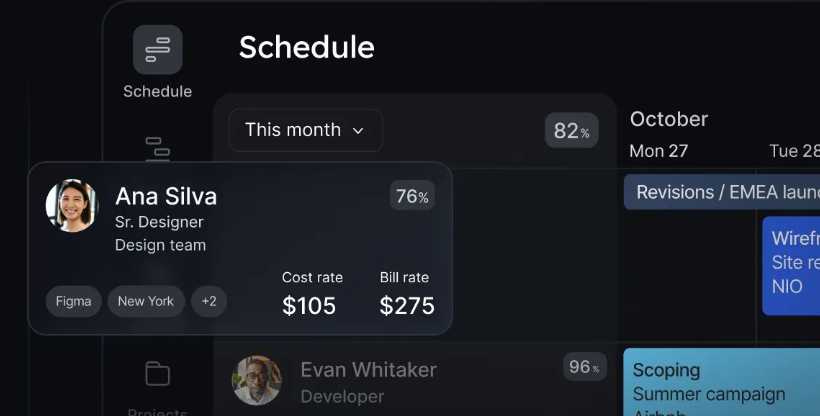
Float is a well-established resource-management platform. It helps organisations plan capacity, forecast revenue, and improve margins, combining people-first scheduling with integrated financial insight.
TL;DR
- Best for: Teams wanting fast, visual scheduling with real-time profitability tracking.
- Core strength: Clear visibility of capacity, skills, and financial performance in one place.
- Ideal for: Professional-services and creative teams balancing utilisation and margin.
- Integrations: HubSpot, Linear, monday.com, Zapier, Slack, Asana, Jira, Google Calendar, Outlook, and more.
- Compliance: B Corp certified since March 2024; GDPR & AICPA SOC 2 compliant.
Why teams choose Float
Float is designed to help teams build a good resourcing plan, aligning availability, skills, and workload with target margins. Managers can see, in real time, how changes to staffing affect utilisation and profitability. The newly released Finance & Estimations features allow teams to set baseline budgets, forecast revenue, and compare actuals against estimates throughout each project.
Its drag-and-drop schedule gives an instant view of who’s booked, who’s free, and how projects map across teams and time zones.
Key features
- Centralised resource planning: Assign people to work based on capacity and skill fit.
- Financial insights dashboard: Monitor margins, utilisation, and revenue forecasts.
- Project scoping and estimations: Set budgets and track profitability from day one.
- Leave and availability management: Integrate time-off data for accurate capacity forecasting.
- Integrations ecosystem: Connect people, project, and financial systems via direct APIs or Zapier.
What users say
Verified reviewers generally highlight Float’s usability and visibility across teams, while noting that large schedules can feel dense at times:
“Easy to use but can look like an info dump… very easy to use, and I like the filter so I can see just me.” — Capterra review, July 2025 (4.0 / 5)
Across hundreds of reviews, users consistently mention Float’s quick setup, clear scheduling views, and helpful integrations for managing multiple projects.
When Float fits best
Float suits organisations that need real-time visibility into people, projects, and profit without heavy configuration.It’s widely used by agencies, consultancies, and teams wanting a clear link between staffing decisions and financial outcomes.
Verdict
With its combination of visual simplicity and financial awareness, Float remains a dependable choice for teams focused on balancing utilisation, wellbeing, and profit.
#3 Resource Guru
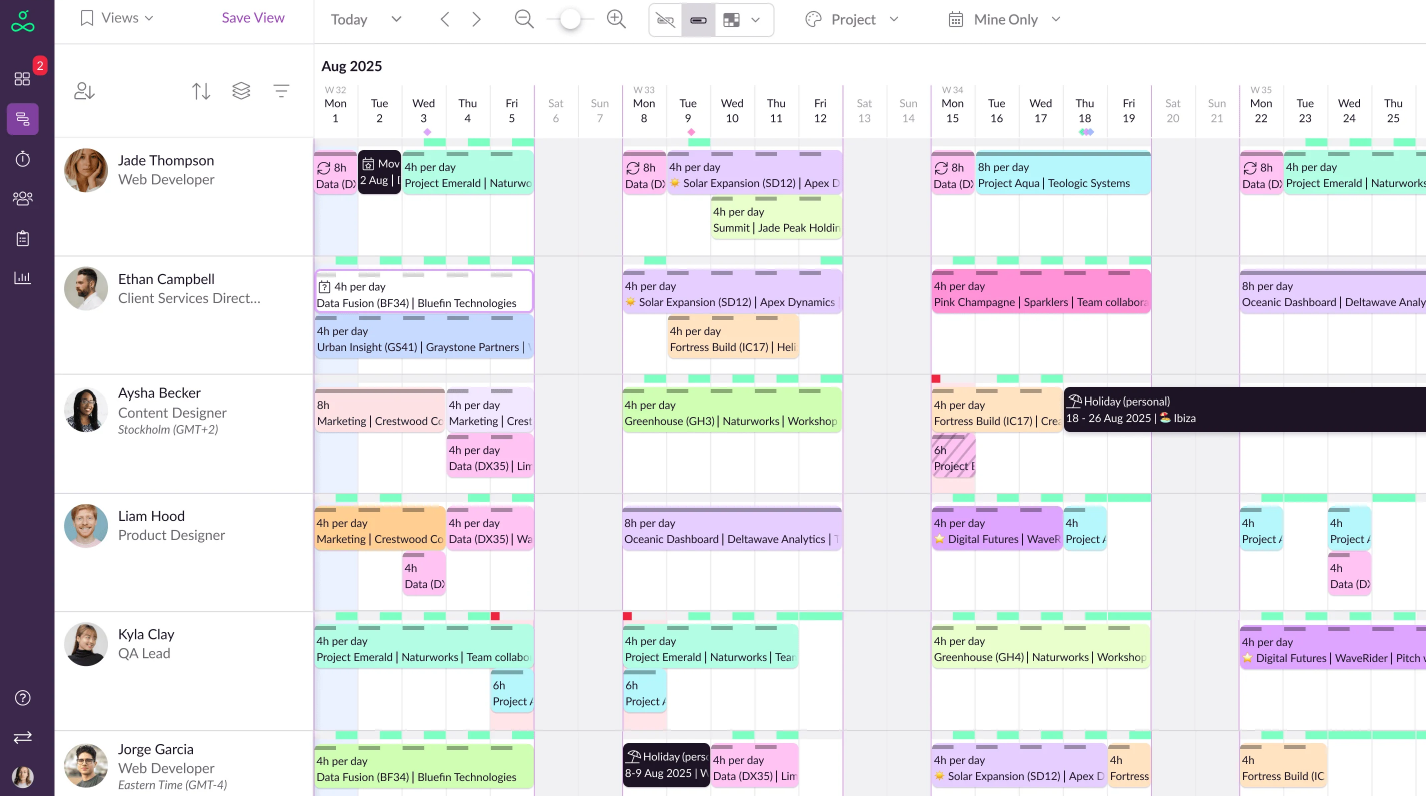
Resource Guru is a straightforward yet powerful resource management platform. It helps teams plan workloads, track utilisation, and prevent scheduling conflicts using clean visual dashboards and heatmaps.
TL;DR
- Best for: Teams that need fast, centralised visibility into workload and availability.
- Core strength: Colour-coded heatmaps that highlight under- or over-utilisation in real time.
- Ideal for: Agencies, engineering teams, IT, and firms managing multi-project capacity.
- Integrations: Google Calendar, Outlook, Slack, Microsoft Teams, Jira, Smartsheet, Asana, Trello.
Why teams choose Resource Guru
Resource Guru is built around simplicity and speed. Its team calendar and heatmap views make it easy to see who’s available, who’s fully booked, and where gaps exist — all at a glance.
For managers, this visibility helps prevent overallocation and ensures fair workload distribution across projects.
It’s equally useful for operational leaders who need to manage people, meeting rooms, and shared equipment in one central schedule. With approval workflows, clash management, and waiting lists, Resource Guru provides guardrails that reduce scheduling friction in busy project environments.
Standout features
- Heatmap dashboards: Quickly visualise availability and capacity across teams.
- Clash management: Automatic detection and resolution of double bookings.
- Custom fields and filters: Tailor scheduling by skills, location, or department.
- Leave management: Track holidays and absences in the same calendar.
- Daily summary emails: Keep individuals informed of their upcoming bookings.
What users say
Verified reviewers frequently mention Resource Guru’s intuitive interface and speed of adoption:
“Easy to use UX… overall the tool is great and easy to use, but it lacks some more detailed project-management features.” — Capterra review, January 2025 (4.0 / 5)
Across hundreds of reviews, users highlight the platform’s clear visibility and straightforward implementation, particularly for teams scheduling people and equipment across multiple projects.
When Resource Guru fits best
Resource Guru suits organisations that want an intuitive, no-frills view of capacity without needing complex financial or compliance tracking.
It’s often used by creative agencies, consultancies, and technical delivery teams looking to keep workload planning transparent and efficient.
Verdict
Resource Guru continues to stand out for its visual simplicity and speed. Its intuitive dashboards and heatmaps make it easy to manage availability at scale: ideal for teams that prioritise visibility and coordination across multiple projects.
#4 Dayshape
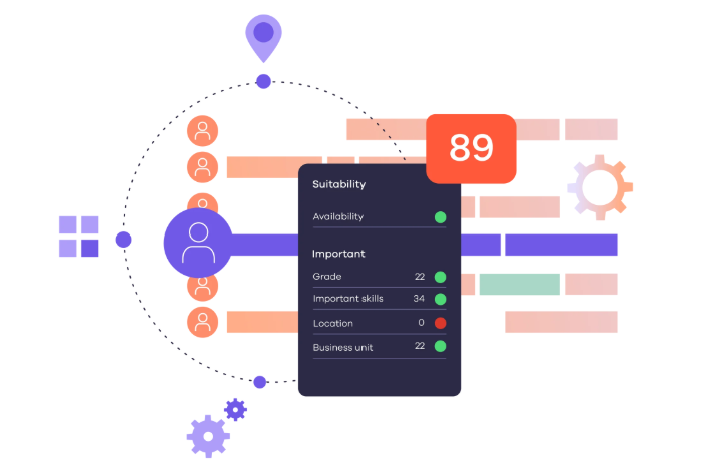
As one of the newer AI-led platforms in the space, Dayshape uses automation to assist with scheduling, forecasting, and planning.
TL;DR
- Best for: Organisations exploring AI-assisted scheduling tools.
- Core strength: Automated resource allocation and forecasting.
- Ideal for: Teams interested in predictive recommendations to support planning.
- Pricing: Available on request.
- Integrations: Microsoft Power BI, Salesforce, Workday, and other HR/ERP systems.
Why teams choose Dayshape
Dayshape appeals to organisations that want to incorporate automation into their planning process. The platform uses algorithms to analyse availability, project data, and profitability targets to suggest scheduling options. Its reporting features help managers understand capacity and utilisation across teams.
Standout features
- Automated scheduling suggestions: Assign people based on availability and criteria set by managers.
- Profitability insights: Link resource plans with margin and revenue goals.
- Scenario modelling: Compare potential project plans before confirming.
- Forecasting dashboards: Track workload and performance indicators over time.
- Integrations: Connects with common business systems for reporting and analytics.
What users say
Feedback across review sites highlights Dayshape’s benefits:
“Dayshape is very user friendly and intuitive…. The dashboard page isn't very customizeable. I'd like to be able to have better dashboards avaialble for partners and managers to get the data they need specific to their own engagements.” — G2 review, 2025
Overall sentiment shows appreciation for the visibility it offers once implemented.
When Dayshape fits best
Dayshape suits firms that need integration with financial and HR systems, or operate within multiple geographies and compliance frameworks.
Verdict
Dayshape provides a robust, automation-focused solution for organisations that manage resourcing at scale. Its AI scheduling and forecasting capabilities can help improve efficiency in large, structured environments, while its integration options make it adaptable to established enterprise systems.
For more information about how Dayshape compares to Retain, check out our detailed comparison here. In summary, Dayshape is one of the newer entrants in the market. By contrast, platforms with a longer heritage in professional services, such as Retain, have evolved through decades of refinement and client feedback, balancing innovation with operational depth and reliability. The distinction often comes down to preference: automation-first or experience-proven.
#5 Productive
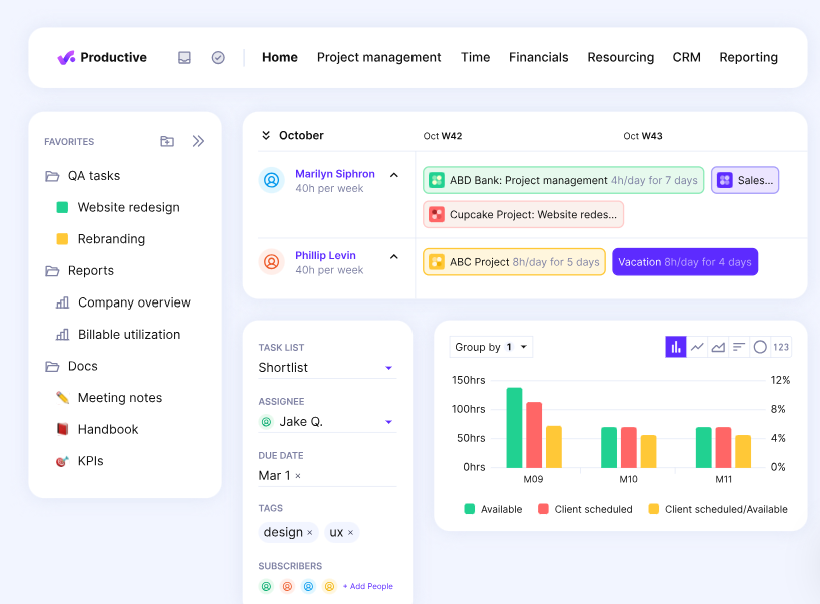
Productive is a planning and business-management platform designed primarily for agencies and service-based teams. It connects resource scheduling with time tracking, budgeting, and financial performance, so teams can see how utilisation links directly to profit margins.
TL;DR
- Best for: Agencies and consultancies that want visibility into utilisation and profit in one platform.
- Core strength: Linking people planning with financial metrics and project billing.
- Ideal for: Marketing, creative, and professional-services agencies managing multiple clients.
- Integrations: Slack, HubSpot, QuickBooks, Xero, Microsoft Teams, Google Workspace, Jira, Asana, Trello.
Why teams choose Productive
Productive provides an all-in-one workspace that unites capacity planning and financial management. Users can allocate team members, forecast workloads, and compare planned vs. actual revenue, all within the same interface. For agencies that juggle many clients and projects, this integrated view helps maintain visibility of both delivery and profitability.
Standout features
- Capacity forecasting: Predict workload and track team availability.
- Profitability dashboards: Compare planned and actual margin performance.
- Time tracking: Capture billable hours directly within each project.
- Scenario planning: Model resource and rate changes before approval.
- Custom reports: Combine utilisation, time, and financial data into shareable dashboards.
What users say
“Very efficient and user-friendly tool that caters to a broad aspect of agencies’ needs: project management, time logs, budgeting, reporting, etc.” — Sonja V, Chief Clients Officer, Marketing & Advertising (Capterra, Nov 2024)
“Resourcing can be a bit off, some bugs.” — Julia M, Project Manager, Management Consulting (Capterra, Sept 2025)
“The navigation inside the app is not always clear… when adding time outside budget dates, the error was annoying.” — Dave B, Developer/Owner, Computer Software (Capterra, Feb 2024)
User feedback consistently highlights Productive’s breadth, covering both financial and operational needs, with occasional notes about interface complexity or navigation.
Verdict
Productive offers a comprehensive, finance-aware platform for agencies that need real-time visibility into people and profit. Its clear dashboards and forecasting tools make it a practical choice for service-based teams seeking better alignment between workload and financial performance.
#6 Scoro
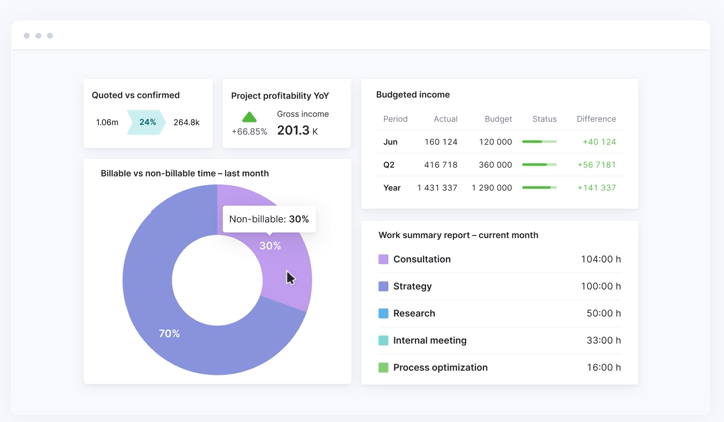
Scoro is an all-in-one work management platform that combines project planning, financial control, and resource scheduling in a single environment. It’s designed to give managers visibility into utilisation, budgets, and performance metrics across teams and clients.
TL;DR
- Best for: Businesses that want a single tool to manage projects, resources, and finances together.
- Core strength: End-to-end visibility from quoting and delivery through to invoicing and reporting.
- Ideal for: Professional services, consultancies, and agencies needing unified control of operations.
- Integrations: Xero, QuickBooks, Sage Intacct, Expensify, Stripe, Jira, Slack, Asana, Dropbox, PayPal.
Why teams choose Scoro
Scoro helps firms connect the dots between time, resources, and financial performance. It centralises task management, time tracking, and billing in one workspace, offering real-time visibility of workload, profitability, and client commitments.
Managers can monitor billable and non-billable hours, plan upcoming workloads, and ensure utilisation targets align with project budgets, all without switching between tools.
Standout features
- Resource scheduling: Assign and balance workloads using visual planners.
Financial management: Track revenue, expenses, and margins per project. - Integrated quoting and invoicing: Manage sales and delivery workflows within the same system.
- Forecasting tools: Predict revenue and capacity using real-time utilisation data.
- Custom dashboards: Combine operational and financial KPIs for quick reporting.
What users say
“Quoting work in Scoro is super easy, and the dashboards mean I can see where me and my team are spending too much or too little time.” — Joe G, Head of Client Services, Marketing & Advertising (Capterra, Jul 2025)
“With an easy-to-use interface, clear workflows and simple reporting, it gives us a real-time view of performance and helps us make decisions using the right data.” — Tony W, Managing Director-Operations, Management Consulting (Capterra, Sep 2025)
“The user interface is overly complex… hard to locate specific jobs, and time tracking isn’t as intuitive as expected.” — Ian M, Senior Account Director, Marketing & Advertising (Capterra, Apr 2024)
“You have to manually enable the email notification option every time.” — Kelly B, Design Engineering Manager, Computer Software (Capterra, Nov 2023)
Feedback highlights Scoro’s comprehensive visibility and reporting tools, alongside comments about interface complexity and manual notification settings.
Verdict
Scoro delivers strong integration between project, time, and financial management, which is ideal for firms seeking an all-in-one operations platform. For teams whose focus lies specifically in advanced resourcing, skills visibility, and capacity optimisation, complementary or specialist tools can extend beyond Scoro’s generalist scope.
#7 Kantata

Kantata is a professional services automation (PSA) platform that connects project delivery, financial management, and resource planning. It’s designed to help service organisations manage people, projects, and profits in one system, with a strong focus on visibility and forecasting across client engagements.
TL;DR
- Best for: Service delivery teams managing people and financial performance together.
- Core strength: Blending resource planning with project and portfolio management.
- Ideal for: Medium to large service organisations balancing utilisation and margin.
- Integrations: Salesforce, Xero, BambooHR, Jira, Slack, QuickBooks, HubSpot, NetSuite, Workday.
Why teams choose Kantata
Kantata unites scheduling, project tracking, and financial management in one PSA environment.
Its dashboards help leadership teams monitor utilisation, profitability, and capacity across multiple projects. The platform also includes scenario planning, allowing users to model how staffing or budget changes could affect performance metrics before making adjustments.
With its Salesforce integration, Kantata is often used by organisations that want resourcing and delivery data closely aligned with sales and client pipelines.
Standout features
- Resource forecasting: Plan people and skills across multiple projects.
- Scenario planning: Model staffing and timeline options in advance.
- Project portfolio management: Gain a consolidated view of ongoing engagements.
- Financial reporting: Track revenue, margin, and billable utilisation.
- Workflow automation: Build approval and delivery processes for consistency.
What users say
“It’s a fantastic time and task management system. Having Mavenlink sit directly on Salesforce has given us a more complete view from pre-sales through project close-out. From a resource management perspective, everything has been well executed.” — Capterra review, June 2022 (4.0 / 5)
“We like the ability to share a workspace with clients, but reporting can feel cumbersome and difficult to navigate.” — Alyssa M, Director of Project Management & IT, Information Technology & Services (Capterra, Mar 2021, 3.0 / 5)
Reviews highlight Kantata’s strength in connecting sales and delivery data through Salesforce, while some users note that reporting workflows can feel complex or take time to configure.
Verdict
Kantata is a capable PSA solution for organisations wanting unified project and financial visibility. For firms seeking a resource-first approach that prioritises skill alignment, utilisation optimisation, and cross-team coordination, platforms like Retain provide a more specialised and established foundation.
#8 Hub Planner
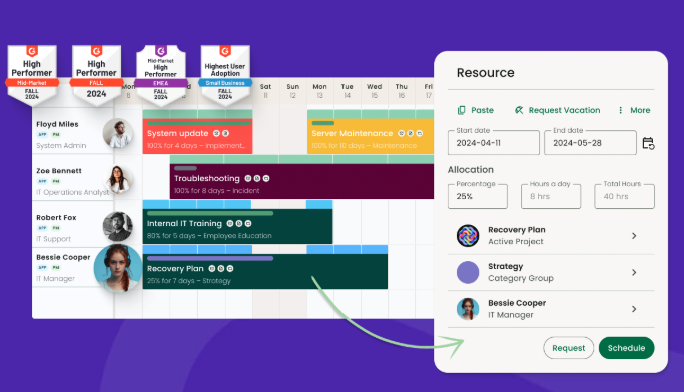
Hub Planner is a resource scheduling and time-tracking platform built to help teams plan, allocate, and monitor workloads in one place. It’s often used by operations and project managers who need an overview of team availability and project capacity across multiple departments or clients.
TL;DR
- Best for: Teams managing multiple projects and needing clear visibility of schedules and workloads.
- Core strength: Centralised calendar view with powerful reporting and utilisation insights.
- Ideal for: Medium to large teams balancing project capacity and time tracking.
- Integrations: Jira, Slack, Trello, Asana, Microsoft Outlook, Google Calendar, Basecamp, Salesforce, Harvest.
Why teams choose Hub Planner
Hub Planner gives managers a real-time overview of team capacity, allowing them to assign tasks, plan leave, and track utilisation in a visual schedule. Its drag-and-drop calendar and filter options make it straightforward to see who’s available, which projects are running, and how workloads are distributed.
The platform’s built-in timesheets and reporting dashboards provide an overview of actual versus planned hours, helping teams balance workloads and avoid bottlenecks.
Standout features
- Drag-and-drop scheduling: Plan people, projects, and events from one central calendar.
- Heatmaps and capacity views: Spot under- or over-utilised team members instantly.
- Leave and vacation management: Track time off directly within the scheduling interface.
- Reporting suite: Generate utilisation, time, and budget reports in real time.
- Role-based access: Limit visibility or control for different user types.
What users say
“Useful for businesses who are starting up and scaling up.” — Matthew S, CEO, Information Technology & Services (Capterra, Mar 2023)
“We have added new software in other areas as we’ve grown and needed better connectivity between systems than Hub Planner could provide.” — Mark B, Director of Finance, Management Consulting (Capterra, Aug 2023)
“I mostly use the scheduling view — the small bugs are perhaps the most significant annoyance to me.” — Matti H, Head of Consulting, Computer Software (Capterra, Aug 2022)
“Correcting errors in the system has caused a problem and does require contacting support for corrections.” — Tiffanie R, Recruiter, Information Services (Capterra, 2023)
Feedback consistently highlights Hub Planner’s value for growing teams and early-stage scaling, with users praising its scheduling visibility while noting occasional bugs and support reliance when resolving system errors.
Verdict
Hub Planner remains a reliable choice for teams needing a centralised, visual scheduling tool. It’s valued for its intuitive design and real-time visibility, making it a practical fit for growing organisations looking to simplify how they plan and manage capacity.
#9 monday.com
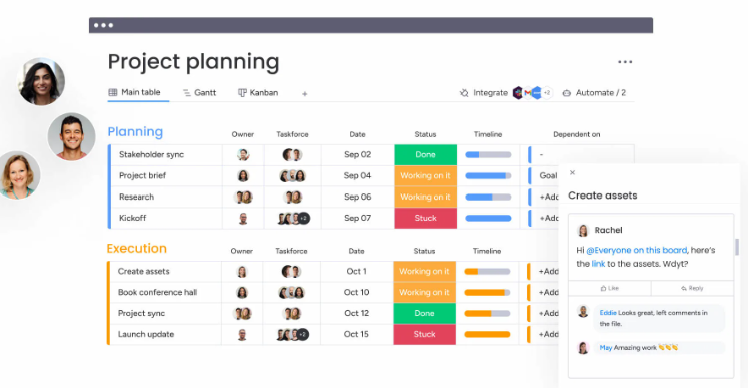
monday.com is a flexible work and project management platform that allows teams to visualise workloads, track progress, and collaborate in one shared workspace. While not built exclusively for resource management, its customisable boards and dashboards make it a popular choice for teams seeking clarity over time allocation and responsibilities.
TL;DR
- Best for: Small to mid-sized teams wanting simple workload tracking and collaboration.
- Core strength: Easy-to-use boards that visualise tasks, timelines, and team capacity.
- Ideal for: Teams that value flexibility and quick setup over complex configuration.
- Integrations: Google Drive, Slack, Excel, Outlook, GitHub, Dropbox, Typeform, Zapier, Asana, Trello.
Why teams choose monday.com
monday.com is designed for versatility. Its drag-and-drop interface and colourful dashboards make it simple for users to track tasks, manage deadlines, and monitor workloads across departments. For teams without a dedicated resourcing tool, monday.com’s workload view provides a clear snapshot of who’s busy, what’s next, and where capacity exists.
Automation features also help reduce manual admin by automatically updating task statuses, sending notifications, and adjusting dependencies when priorities shift.
Standout features
- Workload view: Visualise assignments and available capacity by team member.
- Timeline and Gantt charts: See how tasks align with deadlines and milestones.
- Automations: Trigger updates and reminders based on changes or due dates.
- Dashboards: Combine multiple boards into a single view for reporting.
- Integrations: Connect with hundreds of popular apps through direct integrations or Zapier.
What users say
“Good customisation and customer service but not my favourite project management tool. It’s on level with Trello — user-friendly but limited for teams who find tools like Jira too complex or expensive.” — Capterra review, Oct 2025 (3.0 / 5)
“monday.com is a modern tool for project management. It can streamline operations, enhance productivity, and ensure real-time progress tracking.” — Julie E., Directrice Marketing et Communication Digitale, Restaurants (Capterra, Oct 2025, 4.0 / 5)
Feedback highlights monday.com’s accessibility and visual interface, with users noting it’s easy to customise and suitable for teams seeking a straightforward, modern workspace — though some view it as more lightweight compared to specialised project or resource management tools.
Verdict
monday.com remains one of the most approachable and user-friendly tools for visual workload planning. It’s a strong choice for teams starting their resource management journey and can easily scale through integrations and automation as needs grow.
#10 Wrike
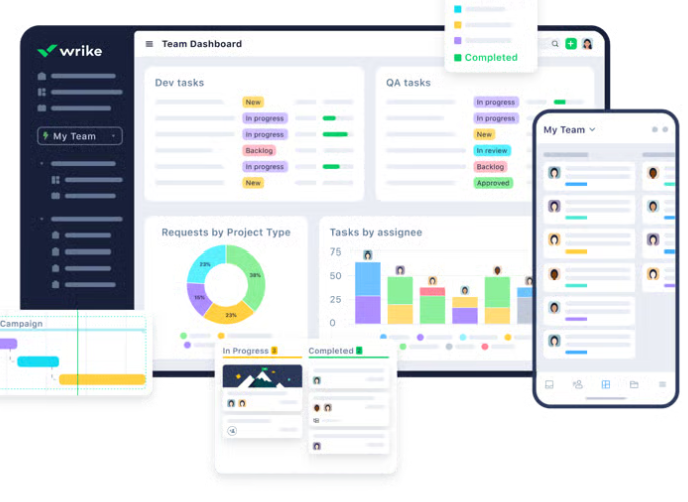
Wrike is a collaborative work management platform that combines task tracking, resource planning, and reporting in one system. It’s designed to help organisations coordinate projects across teams and departments, offering flexibility through custom dashboards and workflow automation.
TL;DR
- Best for: Teams needing scalable project coordination with built-in resourcing features.
- Core strength: Flexible dashboards and cross-team visibility.
- Ideal for: Mid-sized to large organisations managing projects across multiple functions.
- Integrations: Salesforce, Google Workspace, Microsoft Teams, Dropbox, Slack, Zoom, Jira, Asana, HubSpot.
Why teams choose Wrike
Wrike is valued for its flexibility, as it adapts easily to different workflows, from marketing and operations to IT and product delivery. Its workload view and capacity allocation tools allow managers to assign resources, balance priorities, and track performance in real time.
Teams can also build custom dashboards that display project health, progress, and utilisation data, making it easier for stakeholders to see how work aligns with goals.
Standout features
- Resource allocation tools: Plan and monitor workload by person or team.
- Custom dashboards: Visualise project metrics in real time.
- Automation: Streamline routine updates and status reporting.
- Portfolio management: Oversee multiple projects from a single hub.
- Advanced analytics: Built-in reports for time, utilisation, and performance.
What users say
“Ok time tracking and project management software… Wrike is still very new and they’re actively trying to improve, but if you’re paying for it, it should work without any glitches.” — Capterra review, Sept 2025 (3.0 / 5)
“Much better than our old system of physical folders. The best thing about Wrike is the ability to review artwork from designers instead of re-printing over and over.” — Capterra review, Sept 2025 (4.0 / 5)
User feedback frequently mentions Wrike’s ease of collaboration and document sharing, particularly for creative or remote teams, alongside comments about occasional software glitches and limitations with complex approval workflows.
Verdict
Wrike offers a versatile foundation for managing resources and projects across an organisation.
Its configurable dashboards and collaboration tools make it suitable for growing teams that need clarity and coordination, particularly when paired with specialised resourcing systems for more advanced planning needs.
#11 Meisterplan
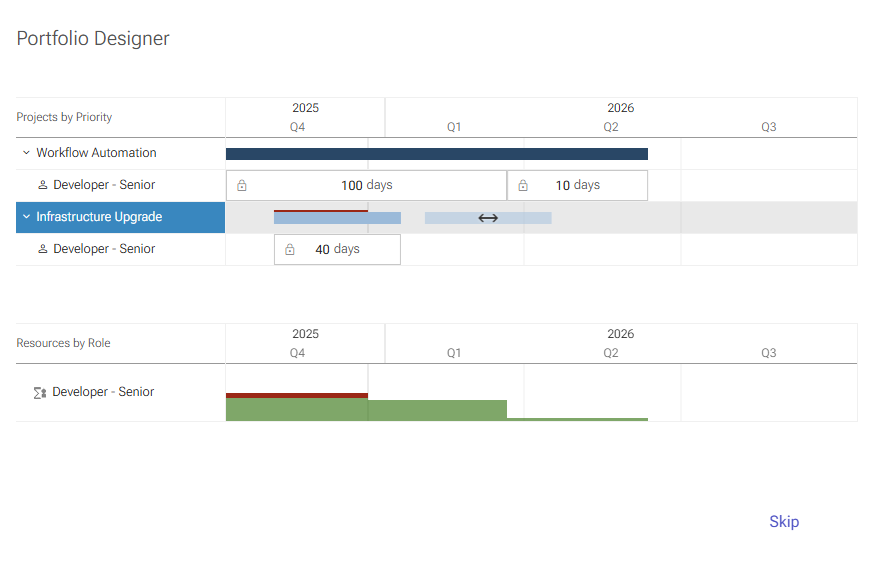
Meisterplan is a resource and portfolio management tool designed for organisations that need to balance high-level capacity planning with project prioritisation. It helps decision-makers visualise demand, resource availability, and the impact of shifting priorities across multiple initiatives.
TL;DR
- Best for: Portfolio and PMO leaders managing multiple concurrent projects.
- Core strength: Scenario planning and high-level resource forecasting.
- Ideal for: Organisations focused on strategic planning and capacity alignment.
- Integrations: Power BI, Jira, ServiceNow, Azure, Clarity, Excel, Zapier.
Why teams choose Meisterplan
Meisterplan is built for leaders who want to connect resource planning with business strategy.
It provides a clear, visual overview of capacity, demand, and priorities, making it easier to evaluate trade-offs and decide which projects to start, pause, or delay. Its what-if scenario planning feature allows teams to model different staffing or portfolio options to see how each decision affects timelines and workload.
Standout features
- Scenario simulation: Test different project and resource plans before approval.
- Capacity management: See where teams are over or under-utilised.
- Portfolio view: Align resource use with strategic goals.
- Real-time analytics: Track demand, performance, and resource health.
- Integrations: Syncs data with leading PMO and reporting tools.
What users say
“Excellent solution — by using Meisterplan we could prioritise the most valuable projects and focus our resources there. It saved us lots of time.” — Michael E., Capterra review, Jul 2015 (5.0 / 5)
“It is easy to use and a powerful portfolio and resource solution.” — Janick W., Head of PMO, Oil & Energy (Capterra, Nov 2022, 4.0 / 5)
“Meisterplan is an eye-opener for resource bottlenecks… it visualises allocations clearly and makes analysis simple.” — Heiner V., Sales Director (Capterra, Nov 2015, 5.0 / 5)
“Easy to use resource-planning application — we moved from Excel and were up and running in less than a day.” — Benjamin K., Capterra review, Oct 2015 (5.0 / 5)
Reviewers consistently highlight Meisterplan’s clarity in visualising resource bottlenecks, its quick setup compared to spreadsheets, and its effectiveness in helping prioritise high-value projects. Some users note they’d like additional options for day-to-day scheduling, which aligns with its focus on portfolio-level rather than operational planning.
Verdict
Meisterplan offers an excellent top-down view of resources and priorities for portfolio-level decision-making. Its scenario planning and forecasting tools help leadership teams align capacity with business strategy, while complementary tools like Retain can provide the day-to-day scheduling depth and skills insight that Meisterplan intentionally stays above.
How to choose the right resource management software
Choosing resource management software is one of the most important operational decisions a business can make. Get it right, and you gain complete visibility over your people, projects, and profitability. Get it wrong, and you end up back in spreadsheets, manually reconciling data and firefighting capacity gaps.
The best way to avoid that? Focus on fit-for-purpose functionality.
Key takeaways:
- Prioritise platforms built for skills-based resourcing, not just task scheduling.
- Look for live utilisation, forecasting, and scenario planning tools.
- Ensure your system integrates seamlessly with HR, finance, and project tools.
- Demand evidence of scalability, security, and customer success.
- Choose a vendor with proven expertise in your sector.
1. Start with your biggest pain points
Before you compare features, be clear on what’s actually slowing you down. Are you struggling with visibility, overbooking, forecasting, or skills alignment? Defining this upfront helps you filter the long list of tools into a realistic shortlist.
2. Look for true skills-based planning
Most systems still plan around job titles and availability. Modern platforms go deeper matching people to projects based on verified skills, certifications, and experience. That’s where Retain Cloud stands apart: it connects real project data to a living skills framework, helping managers build better-balanced, more effective teams.
3. Check forecasting and scenario planning capability
Project priorities change. Your software should let you model “what-if” scenarios, assess the impact on utilisation, and plan ahead confidently instead of reacting to last-minute changes.
4. Test integration fit
Resource management shouldn’t live in a silo. Look for tools that connect to your existing project, HR, and finance systems to create a single source of truth. Retain Cloud integrates with leading platforms including Microsoft Dynamics, SAP, and Salesforce: keeping data aligned across teams.
5. Ensure scalability and usability
Your resourcing needs will evolve as you grow. Choose software that scales across departments and geographies without losing performance or usability. A long-standing vendor with a proven enterprise customer base (like Retain) offers both maturity and flexibility.
6. Demand actionable insights
Beyond scheduling, great resource management tools should help you make strategic decisions. Look for dashboards and analytics that highlight:
- Utilisation and billability trends
- Profitability by project or team
- Skills gaps and development opportunities
7. Evaluate vendor credibility
Longevity, expertise, and real-world impact matter as much as features. Check certifications, customer reviews, and case studies. Retain has supported more than 1.5 million users worldwide for over 30 years, giving professional services firms the confidence of a platform built for lasting performance.
In summary
When choosing resource management software, the right platform should seamlessly connect people, projects, and profitability.
For firms ready to move beyond manual planning and towards smarter, skills-driven scheduling, Retain Cloud provides the clarity and control to plan with confidence.
👉 Book a demo to see how Retain can help you build a more efficient, more profitable resourcing strategy.
Conclusion: The proven choice for professional services
The resource management software market is growing fast, but experience counts. While newer platforms bring automation and modern UI, few understand the complexity of professional services resourcing like Retain.
For more than 30 years, Retain has helped firms around the world plan, forecast, and deliver with confidence. Our heritage in professional services means we understand the balance between client demand, people availability, and profitability as a single, connected ecosystem.
Where other tools focus on task lists or surface-level scheduling, Retain goes deeper.
It combines skills-based matching, behavioural insight, and financial visibility in one intuitive platform, giving firms complete control over how work is allocated and delivered. That’s why leading organisations across consulting, accounting, and technology rely on Retain to optimise utilisation, improve project margins, and build happier, higher-performing teams.
So, as you evaluate your options, remember this: the best resource management tool isn’t new gimmicks, it’s proven.
👉 Retain Cloud offers the reliability of a long-established partner with the innovation of a modern SaaS platform. It’s trusted, tested, and built specifically for firms that run on people.
Book a demo to see why over 1.5 million professionals choose Retain to power their resourcing decisions.
Frequently Asked Questions
1. What is Retain and who is it for?
Retain is a resource management platform built for professional services, including consulting, accounting, engineering, and technology firms. It helps businesses plan capacity, forecast demand, and match the right people to the right projects with full financial visibility.
2. How is Retain different from other resource management software?
Unlike general project tools, Retain focuses on skills-based resourcing, behavioural insights, and profitability tracking. With over 30 years of heritage, it combines the depth of an enterprise solution with the agility of modern cloud software: trusted by over 1.5 million users worldwide.
3. Does Retain use AI for resource management?
Yes. Retain Cloud uses AI-enhanced skills matching and data-driven forecasting to help managers allocate work more intelligently. The system identifies best-fit resources based on skills, certifications, experience, and behavioural traits, not just availability.
4. Is Retain suitable for hybrid or remote teams?
Absolutely. Retain Cloud supports global, hybrid, and remote work models. Managers can see team capacity in real time, while employees can update their availability and project allocations from anywhere, on any device.
5. How much does Retain cost?
Retain offers flexible pricing based on the number of users and deployment type. Cloud plans start for smaller teams, with enterprise packages for large or global firms. Book a demo for a tailored quote based on your organisation’s structure and requirements.
6. How long does it take to implement Retain Cloud?
Implementation typically takes 4–8 weeks, depending on your data migration and integration needs. The Retain onboarding team handles setup, system configuration, and training, ensuring a smooth transition from spreadsheets or legacy tools.
7. What results can teams expect from using Retain?
Professional services firms using Retain typically see measurable improvements in:
- Utilisation (15%)
- Planning efficiency (40–60% time saved)
- Project profitability and forecasting accuracy
- Employee engagement and retention
8. What integrations does Retain offer?
Retain integrates with leading business systems including Microsoft Dynamics, SAP, Salesforce, Workday, and Office 365. These integrations sync project, HR, and finance data, giving teams one reliable view of people, performance, and profit.


